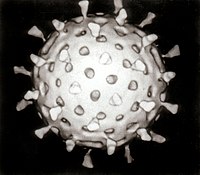
Photo from wikipedia
BACKGROUND During the last decade, most of Latin American and the Caribbean (LAC) countries have implemented oral live rotavirus vaccines in their national vaccination programs with remarkable results. However, it… Click to show full abstract
BACKGROUND During the last decade, most of Latin American and the Caribbean (LAC) countries have implemented oral live rotavirus vaccines in their national vaccination programs with remarkable results. However, it has been suggested that massive vaccination could lead to the replacement of circulating genotypes or the emergence of new variants or neutralizing antibodies escape mutants, which may reduce the effectiveness of the vaccine. The objective was to analyze the genetic diversity of Group A rotavirus before and after the introduction of universal vaccination in LAC. METHODS We conducted a systematic review of studies published in PubMed, Scielo and LILACS. There were considered only LAC countries with rotavirus massive vaccination strategy which had described circulating genotypes data in children under 5 years of age, either for surveillance or vaccine effectiveness purposes, from 2001 to 2017. Systematic review stages were carried out following the recommendations of PRISMA. RESULTS Of the 18 countries that included any of the two licensed rotavirus vaccines in their national schedules since 2006, only 7 (~39%) presented studies of RVA genetic diversity before and after implementation, and met the inclusion criteria. Four of them (Argentina, Brazil, Colombia and Nicaragua) experienced a rapid switch from Wa-like to DS-1-like strains. Also, G1P[8] association, considered the most predominant worldwide in the pre-vaccination era, decreased significantly and was only frequently detected in Venezuela and Nicaragua. No defined pattern of emergence at high frequencies of unusual associations was observed in the post vaccination period, except for some evidence of G9P[4] in Colombia, G3P[6] and G1P[4] in Nicaragua. CONCLUSIONS Even though the evidence shows a DS-1-like change trend, data from studies conducted in Latin America and the Caribbean are diverse and still not sufficient to assess the impact of vaccines on viral ecology or if genetic diversity is influenced by natural mechanisms of fluctuation.
Journal Title: Vaccine
Year Published: 2019
Link to full text (if available)
Share on Social Media: Sign Up to like & get
recommendations!